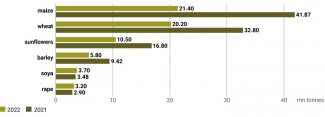Agricultural production in Ukraine has declined significantly
According to information from the Ministry of Agrarian Policy and Food of Ukraine, in 2022 the harvest of the main types of cereals (corn, wheat and barley) and oil crops (sunflower, soybean and rapeseed) amounted to nearly 65 million tonnes, which is almost 40% less than in the previous year (see Chart 1). However, this significant decrease in production had only a limited impact on exports of these product categories, which last year amounted to nearly 60 million tonnes (-13% y/y, see Chart 2), partly due to the sale of stocks from 2021. According to the Ministry’s estimates, the area under cultivation in 2023 will shrink by around 7 million hectares (24%) compared to 2021, from 29 million to 22 million hectares. Forecasts regarding the harvest of cereals this year predict a drop of around 15%, to 46 million tonnes.
Commentary
- The lower harvest in 2022 was due to a number of factors, the most important of which is the Russian invasion. Russian troops occupied part of the country and mined the fields, which made it difficult or impossible to harvest. Another reason was the worse than usual weather conditions. It should also be stressed that 2021 saw the highest harvest in the history of independent Ukraine, which makes the reduction in production appear so alarming.
- The largest decreases concerned relatively cheap export species, in particular maize. This had been on the verge of even making a profit: at the end of 2022, up to 19% of maize was still in the fields, and 9% was there at the beginning of this February. Meanwhile, the harvest of more expensive species such as rapeseed and soybean actually rose. This was because of the rise in the costs of transport, logistics and insurance related to exporting the products – both through the three available Black Sea ports (as part of the so-called grain corridor), as well as by land across the border with the EU. Everything indicates that this year’s harvest will continue to decline, although this will not affect Ukraine’s food security, as most of its agricultural produce has been exported for years, and domestic consumption has shrunk as a result of the departure of several million citizens from the country.
- We should expect foreign sales of cereals to slow down strongly in 2023. This trend will primarily affect the less profitable species, especially maize. It is worth noting that exports of the latter were higher in 2022 (25 million tonnes) than production (21.4 million tonnes), because (as already mentioned) the stocks accumulated in the previous year were also sold. We can also assume that shipments of oils and oil crops abroad will remain at last year’s levels, or even increase. Despite this, the decline in income from the sale of agri-food products, which in 2022 accounted for more than half of all exports (in 2021, it generated 10% of Ukraine’s GDP), will have a painful impact on the country’s economy. At the same time, it seems that these limitations on production and sales will only be temporary: after the war ends and the supply chains are unblocked, we should expect them to rebound significantly.
Chart 1. Size of harvests of Ukraine’s main cereals and oil crops in 2021 and 2022

Source: Ministry of Agrarian Policy and Food of Ukraine, State Statistics Committee of Ukraine.
Chart 2. Value of exports of Ukraine’s main agricultural products in 2021 and 2022

Source: Customs Service of Ukraine.





